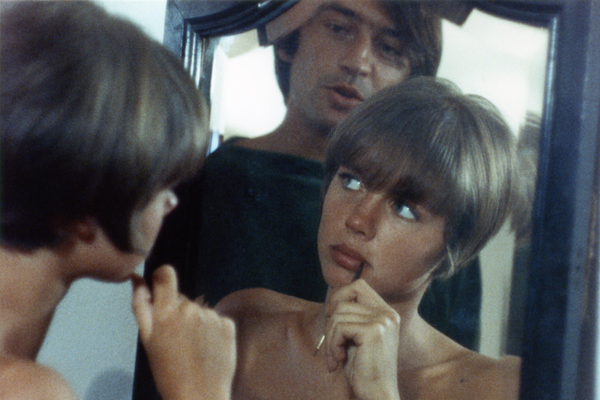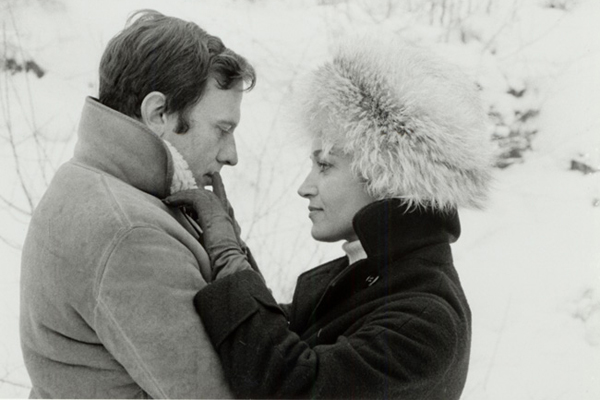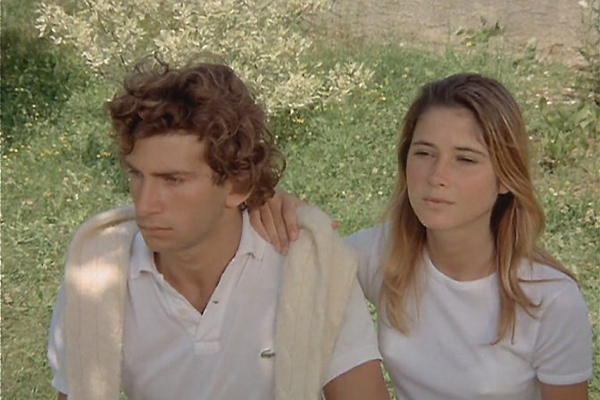Everything Humanly Possible
The films La Collectionneuse and My Night at Maud's are being shown at Museum of the Moving Image on December 7, 2013, as part of the series See It Big!: Great Cinematographers. Nestor Almendros was the subject of a major retrospective, Man With a Movie Camera, at the Museum of the Moving Image in 1990. This article is published in collaboration with Reverse Shot, which is also the Museum's partner in programming See it Big.
The four films that Eric Rohmer made with cinematographer Nestor Almendros between 1967 and 1972 are the major works of the director’s Six Moral Tales. (The first two installments in the series had been The Bakery Girl of Monceau, a breezy 23-minute sketch, and Suzanne’s Career, an astute but slightly slack almost-feature.) Rohmer was in his mid-forties when he made the first of these films, a half-generation older than most of his fellow Cahiers du cinéma critics-turned-directors, and his movies from this period strike a seductive balance between worldliness and curiosity; gravity and playfulness; wisdom and spunk.
Almendros was a decade younger and at the earliest stage of his career—his only credits at the time were a trio of Rohmer’s early shorts—but he had already started working through a set of methods for filming the play of sun on surfaces and the passage of light through air. (While filming La Collectionneuse, for instance, he discovered—half by accident, half by trial—that Kodak film stocks were much more sensitive to low lighting conditions than common wisdom at the time suggested.) The Moral Tales were made on slim budgets with tight schedules and economical shooting ratios, and although a good chunk of each movie’s copious dialogue emerged on the fly in rehearsal, the final lines were sculpted with literary precision: Rohmer wrote each film in the form of stripped-down stories somewhere between novellas and shooting scripts. The resulting films feel at once tightly wound and inconclusive. Their narrative trajectories are progressive variations on a common theme, their photographic styles a record of Almendros’s growing confidence behind the camera, and their set of moral preoccupations more or less constant.

La Collectionneuse
Each film centers around a man stuck between young adulthood and middle age, torn between two women—one usually absent and idealized, the other threateningly present—and hopelessly lost in his own head. La Collectionneuse (shot before My Night at Maud’s, though released after) is the cruel name given by art dealer Adrien and his painter friend Daniel to Haydée, the young woman with whom they find themselves rooming in a friend’s villa on the Riviera, and whose sexual freedom deepens their jealous, insecure streaks. (They accuse her of collecting men.) Jean-Paul, the hero of My Night at Maud’s, lives an austere life consisting mainly of working through mathematical proofs and reading Pascal. He sets himself on marrying a girl he sees each week in Mass, but when an old friend’s invitation strands him overnight at the home of a beautiful divorcée, he’s forced to acknowledge his deep-set pretensions, his rigid defenses, and his fear of fully revealing himself. In Claire’s Knee, engaged diplomat Jérôme finds himself at a lakeside retreat enjoying the advances of an impetuous, dissatisfied teenager named Laura—not to mention making some of his own toward her bombshell half-sister, Claire. He reports his findings to his novelist friend Aurora in a series of intricate verbal exchanges: he fatuously self-satisfied, she poking knowingly at his sorest, most insecure points. Chloe in the Afternoon, the final film in the series, is the story of a happily married businessman slowly led to the brink of infidelity after striking up a strong rapport with an old friend’s ex. Each film is structured around a series of extended conversations, which give the men room to engage in elaborate acts of self-deception and the women a chance to alternately manipulate and instruct the men.
Rohmer’s men are chronically passive. They babble on to keep from having to act, and there’s only one set of subjects they know well enough to carry them through so long a filibuster: their own anxieties, desires, biases and hang-ups. The ultimate goal of each of the last four Moral Tales, then, is to force the hero into a situation in which he’ll have to put himself on the line, to commit himself to a single course of action. Each of these gloriously talky films builds to a moment when talk is no longer possible: the chance encounter that gives Adrien in La Collectionneuse a chance to abandon Haydée into the hands of her younger peers; the snowstorm that traps Jean-Louis overnight at Maud’s; the sudden downpour that places Jérôme in a gazebo alone with the teenaged Claire, her knee perilously within reach; Frédéric’s anguished, conflicted gaze into the mirror before embarking on a mid-day tryst in Chloe in the Afternoon. We’ve known all along that Rohmer’s men are proud, but in these moments we realize that they are also profoundly scared of human contact—and that their pride is the logical outcome of the many ways they try to hide, suppress, or compensate for that fear.

My Night at Maud's
What about Rohmer’s women makes them so terrifying to Rohmer’s men? For one thing, as Haydée puts it in La Collectionneuse, they know what they want—or at least they seem to—and are willing to pursue it. When the men are the target of this pursuit, as in My Night at Maud’s, Chloe in the Afternoon, and the first half of Claire’s Knee, they shrink back from it; when they are not, as in La Collectionneuse, they lash out jealously like spurned 12-year-olds. It may seem inconceivable that the women in these films, who are uniformly gorgeous and usually fiercely intelligent, should go out of their way to net these pale, stiff, over-intellectual and/or self-absorbed men, but that’s just one of the many ways in which Rohmer stacks the deck in favor of his male protagonists: random acts of nature, chance run-ins, and fortunate environmental conditions all conspire for their good, with the goal of giving them no reason not to act—or at least no external reason.
Instead, what holds them back is their desire to see all possibilities spread out before them, readily available—hence their resentment when the women they want don’t want them in return—and to keep those possibilities seductively open. Their indecisiveness is really a kind of power-hungriness: they would rather be kings of a world of possibility than dutiful participants in a world of bodies and matter. This is why their “moral” decisions are almost never truly moral. When they deny themselves the pleasure of a onetime fling or the risks of a serious romantic relationship, it’s because they enjoy knowing that they could act if they wanted—but that they could also choose not to. The key exception is Frédéric’s last-minute return to his wife at the end of Love in the Afternoon, which might be the only choice made by any of these men for the sake of someone other than themselves.

Claire's Knee
It’s difficult for feature narratives to suggest unrealized possibilities; most film scenes tend to seem either meticulously mapped out in advance, to the point where every gesture, word, and movement has a slight whiff of inevitability, or edited after the fact into airtight causality. Rohmer and Almendros, in contrast, treat each shot as a series of carefully selected conditions within which their characters have space to move around freely. That’s not to say that Rohmer didn’t have total control over the proceedings—he was notorious for putting his actors through endless rehearsals before even turning on the camera, and for having them stick scrupulously to their lines take after take—but only that he had a gift for giving his movies an impression of contingency and spontaneity. He favored spacious medium shots whenever possible. His camera movement is restrained yet adaptive, as if he’s adjusting for the unexpected trajectories of his subjects on the fly. His scenes often stretch out generously so as to follow a given interaction through to the end, only to cut off brusquely immediately after. Each tiny action or gesture feels free and undetermined; things, we are led to believe, could always have been otherwise. When Laura runs away from a stifling tableful of grownups midway through Claire’s Knee and accidentally overturns a lawn chair in the process, when Jean-Louis locks eyes with Maud for a moment that feels like an eternity, or when Adrien struggles to pull off Haydée’s pants as the two of them prepare to go swimming in La Collectionneuse, it feels as if the movie is arriving at a fork in its own trajectory and opting to move down one path, leaving the other untaken. (For that matter, what if Jean-Louis had never happened to run into the friend who ends up inviting him to Maud’s apartment, or Jérôme into Aurora at the start of Claire’s Knee?)
If the wide-open narrative architecture of these films convinces us that Rohmer’s heroes didn’t necessarily have to gesture, speak, or act as they did, Almendros’s luminous photography makes the fruits of their choices so tangible that it’s hard to imagine them having acted any differently. La Collectionneuse was the cinematographer’s first feature, but it found his signature style all but fully formed: his pioneering reliance on natural light, his warm, sun-dappled color palette, heavy on oranges and yellows (which, he later recalled, was rare at the time, since “it was thought that [dominant warm hues] would make faces look like tomatoes”), his extremely subtle alternation of light, shadow and shade, and his fine-grained eye for surface textures. The movie’s opening shots are a series of close-ups of Haydée’s toned, bikini-clad body as she strolls on the beach; Almendros’s camera, unlike Rohmer’s men, does not shy away from close physical contact with the women in its orbit. My Night at Maud’s was shot in black-and-white and reflects Almendros’s deepening skill at getting a wide range of expressive effects from chilly indoor lights, but it carries over the earlier film’s wealth of textural detail. Looking at the two movies side-by-side, it’s remarkable how Almendros managed to distinguish between the different ways light cuts through air in summer and winter, respectively. Claire’s Knee, shot (like La Collectionneuse) in color by the sea, is packed with bold, saturated greens, reds and blues, whereas the Paris-set Chloe in the Afternoon saw Almendros experimenting with every possible combination of light natural and artificial, halogen and fluorescent, indoor and outdoor, dim and bright.
Although Rohmer’s men may see themselves faced with a spread of unrealized possibilities, to our eyes they seem to inhabit a world of concrete, radiant actualities: a snow-covered city block, a cavernous midnight Mass, a breeze coming in from the sea, a sun-dappled villa. It also happens to be a world they share with women who have the annoying habit of reminding them that they exist as more than abstractions or ideals. Take Maud’s playful come-hither stare and her whispered rebuke (“Idiot!”) when Jean-Louis insists on sleeping stiffly on the chair beside her bed, or Chloe’s command to Frédéric after stepping out of the shower: “Since you’re here, how about drying me.” In both cases, Almendros’s soft, rich photography seems to extend the woman’s invitation, giving her a physical presence denied her by the stubbornly unresponsive man. (Haydée’s prologue in La Collectionneuse, which risks physicalizing her into nonexistence, takes this tendency perhaps a little too far.) In the first three of these films, the lesson the women are trying to teach the men—that they are responsible on a second-by-second bases for the present, actualized state of the world—never sinks in: Adrien abandons Haydée, safe in the knowledge that he could have possessed her, for someone who will let him live in a world of untested what-ifs; Jean-Louis does the same to Maud; Jérôme convinces himself that, by succumbing to Claire’s charms, he has “reached the ultimate delight” and can now settle down with his chilly fiancée.
That leaves only Chloe in the Afternoon. Frédéric, the movie’s hero, is the model Rohmer protagonist: a comfortably bourgeois urban professional in his late thirties who reads a book on the subway because “the paper doesn’t take me sufficiently out of the present.” He has a doting, beautiful wife (plus baby daughter) and no longer desires other women, or so he tells himself. Still, he feels hemmed-in: “When I embrace Hélène,” he tells us in voice-over, speaking for all Rohmer’s possibility-hungry men, “I embrace all women. But I also feel my life passing by as other lives unfold along paths parallel to mine, and it frustrates me to stay cut off from them… I dream that I actually possess them all.” And so, in one of Rohmer’s rare excursions into a character’s imagination, Frédéric finds himself on a street corner wearing a magical seducer’s amulet, picking up several previous Moral Tale heroines as they pass by: Maud, Haydée, Aurora, and Françoise, Jean-Louis’s blonde bride-to-be in My Night at Maud’s. (Laura shoots him down.)
When his capricious old friend Chloe, played by the model-actress Zouzou, tracks him down at work, Frédéric starts taking baby steps in her direction. Wide-lipped, thick-chinned and full-figured, Chloe is one of Rohmer’s most indomitable females, and her afternoon dates with Frédéric are something new for the series: a record of two people growing steadily, reciprocally closer by virtue equally of restlessness, loneliness and strong physical attraction. At one point, he asks her if she’d marry him. “You’re already married,” she shoots back. “Don't you ever dream,” he asks her, “of living two lives at once?” It’s the fantasy of all Rohmer’s heroes: to inhabit multiple presences perfectly and completely, to never know regrets or exclusive commitments; to navigate freely between possible worlds.
The film is building to the moment when Frédéric will need to choose one woman over the other; i.e., one life over another. The moral choice with which he’s faced is a matter of recognizing Hélène and Chloe as more than players in his imagined parallel lives. It’s a matter of seeing them as participants in how his life is, not what it might have been: participants capable of making weighty and, in this case, exclusive claims to his affection. When he finally makes a decision, it feels like a passage into adulthood—and Almendros bathes his tearful reunion with Hélène in warm, late-afternoon sunlight.
![]()
LATEST ARTICLES
-20140814-173707-thumb3.jpg)
Fighting Words
by Imogen Sara Smith
posted August 12, 2014

Fighting Words, Part 2
by Imogen Sara Smith
posted August 20, 2014

On the Margins: The Fil…
by Andrew Chan
posted August 12, 2014

Robin Williams: A Sense…
by David Schwartz
posted August 12, 2014
 Everything Humanly Possible
Everything Humanly Possible

